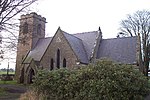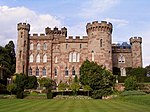Bickley, Cheshire
Cheshire West and ChesterCheshire geography stubsFormer civil parishes in CheshireVillages in Cheshire

Bickley is a village in the parish of No Man's Heath and District in Cheshire West and Chester and Cheshire, England. According to the 2001 Census it had a population of 498, that reduced to 481 at the 2011 census. The parish included the villages of Bickley Town and Bickley Moss. Bickley was a township in the parish of Malpas. In 1866 Bickley became a civil parish and on 1 April 2015 it was abolished to form "No Mans Heath and District".The name is Anglo-Saxon in origin, and relates to bees.The parish church is St Wenefrede's, a grade-II-listed sandstone building designed by John Douglas and Daniel Porter Fordham.
Excerpt from the Wikipedia article Bickley, Cheshire (License: CC BY-SA 3.0, Authors, Images).Bickley, Cheshire
Bickley Town Lane,
Geographical coordinates (GPS) Address Nearby Places Show on map
Geographical coordinates (GPS)
| Latitude | Longitude |
|---|---|
| N 53.0324 ° | E -2.7006 ° |
Address
Bickley Town Lane
Bickley Town Lane
SY14 8EH , No Man's Heath and District
England, United Kingdom
Open on Google Maps







